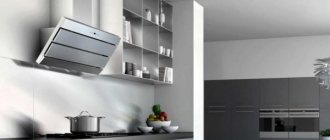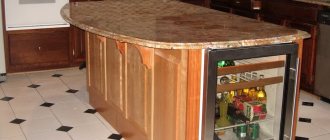When designing the interior of a kitchen with a built-in refrigerator, you need to understand that its operating conditions differ from the operation of free-standing appliances. Consequently, installation requirements will differ.
You can’t just point your finger at the model you like and designate it as suitable for installation in a niche. Built-in household appliances have their own characteristics. The instructions must indicate that the selected brand is suitable for installation in a cabinet or niche. Otherwise, the unit will overheat very quickly and fail.
Advantages and disadvantages
In fact, a built-in refrigerator has many more disadvantages than advantages:
- higher cost than free-standing models of similar functionality and volume;
- the choice of built-in equipment is always smaller;
- additional installation costs will be required (it will not be possible to install and connect such a unit on your own);
- the useful area of the freezer and refrigerator compartments is smaller due to thicker walls (to improve thermal insulation);
- additional costs are required to create an extra kitchen cabinet for the refrigerator.
Against the background of a large number of shortcomings, built-in refrigerators have only one significant advantage - their aesthetic appearance.
Oddly enough, for many, appearance is the main criterion for choosing a refrigerator. People are ready to incur additional costs and difficulties, just so that the entire kitchen set looks beautiful and harmonious.
Selection criteria
First you need to decide on the type of refrigerator:
- without a freezer - very rarely used in apartments. They are more often found in dachas and recreation areas - in places where there is no need for long-term storage, and it is enough to maintain the freshness of food for 1-2 days;
- single-chamber - fairly compact models, suitable for small-sized kitchens in Khrushchev-era buildings. Also, such units are preferred by people who rarely eat at home;
- two-chamber is the most common option. Relatively compact, but quite roomy;
- Side - by - side - two-door refrigerator with a separate freezer. Due to its large size it is suitable only for large kitchens. If the family is large and the kitchen is small, then such models are most often installed in another room: corridor, hallway, living room, dressing room;
- French Door - in size and functionality it can compete with the Side-by-side model. The only significant difference is the absence of an internal partition between the doors, which increases the volume of internal space. The disadvantage of the French Door model can be considered the worst thermal insulation performance, due to the fact that in the middle the doors are adjacent only to each other, and not to the body;
- free-standing modules (wine cabinet for a bar counter, freezer, etc.) - depending on the purpose and manufacturer, the dimensions of such models can vary greatly. Very often, individual modules, just like side-by-side models, are installed not in the kitchen, but in other rooms.
One of the most important factors when choosing a refrigerator is its cost. It depends not only on the brand name and country of origin, but also on a number of general parameters.
Control type
Controlling a refrigerator is the process of setting the required mode and temperature. During normal operation, the settings are changed very rarely, but they do change. For example, they set the economy mode during vacation, etc.
There are two types of management:
- mechanical;
- electronic.
Manual models are usually cheaper, but less functional. Most often they are installed in houses where power surges regularly occur, or where the power is often turned off. The mechanics are more resistant to such situations.
Models with mechanical controls are also preferred by people of the older generation - they are closer and more familiar with it than modern electronics.
Electronic control, in turn, is much more convenient to use. Therefore, if there are no problems with electricity, or finances allow you to install an uninterruptible power supply or an emergency relay (as protection against power surges), then preference is given to models with electronic control.
Defrost type
Ice accumulating on the walls of the freezer leads to increased energy consumption and excessive load on the refrigerator. Therefore, all models require regular defrosting.
There are three ways to defrost a refrigerator:
- Manual.
- Drip (semi-automatic).
- No frost (fully automatic).
The manual method is considered obsolete, therefore it is practically not used in modern technology. Only in the most budget models, and even then, you still need to look for them.
The drip method is considered the successor to the manual defrosting method. The ice in the refrigerator compartment is removed on its own and flows drop by drop into the pan (hence the name). The freezer must be defrosted manually, because the drip method does not work at subzero temperatures.
No frost - fully automatic method. The refrigerator itself solves its problems without interfering with a person and without even informing him of his needs. All liquid is collected in a special pan, from which it is used for the cooling system. It turns out to be a kind of fully automated closed cycle. No frost is the most convenient, modern, but also the most expensive of all existing defrosting systems.
Technical specifications
The most important part of a refrigerator is the compressor. It depends on it how long and efficiently the refrigerator will perform its functions. The compressor can be linear or inverter.
Linear ones are time-tested classics, while inverter ones are more modern devices. They are more expensive, but inverter compressors are more economical and operate quieter.
There are also combined models. Externally, they are no different from ordinary ones, but are equipped with several compressors, each of which maintains the temperature and microclimate in a separate chamber.
Efficiency class
Depending on the amount of energy consumed, all models are divided into several classes:
- A+, A++, A+++ - the most economical models of the latest generation.
- A, B, C - economical models.
- D - intermediate class.
- E, F, G - devices with increased energy consumption.
In addition to the energy saving class, other parameters will also affect energy consumption. For example, the ambient temperature or the frequency of door opening.
Design
Separately, it is worth noting convenient design solutions that make the operation of the refrigerator more comfortable, but increase its cost:
- freshness zone. Different manufacturers call it differently: Fresh Box, Flex Cool or Fresh Zone, but the essence of the zone is the same - maintaining a temperature close to 0 °C. Depending on the model, the freshness zone can be made in the form of a separate box or a separate chamber. In some cases, there may be several freshness zones for different products. In this case, they differ from each other in the humidity maintained in each chamber;
- mini bar. It can be made in the form of an independent section with a separate door, or have the form of a free-standing small block. The presence of a minibar makes the refrigerator more expensive, but helps save money during operation. Products for frequent use are placed in it: drinks, yoghurts, curds. In this case, the main door of the refrigerator has to be opened less often, and, therefore, there is no need to waste extra energy maintaining the desired temperature in the main chamber;
- transparent door. In order not to create the effect of a store display, manufacturers make doors that become transparent only on demand (when you press the touch panel or when you knock on the door). This option allows you to see the contents without opening the door and letting out the precious cold;
- fastenings on the doors. To make it easier to fit a refrigerator into a kitchen set, some manufacturers of built-in appliances equip the doors with special fastenings for the facades. This approach simplifies the process of installing and decorating the refrigerator;
- compressor on top. This feature is due to the need for hidden equipment for additional cooling. With this design, it is much easier to use an additional ventilation window in the headset, or to connect an additional cooling system.
Separate freezer from refrigerator
In a small kitchen it is not easy to place a bulky refrigerator with a freezer as a “second floor”. To adjust the dimensions of the unit, you can install these parts separately. Small appliances can easily be placed under the countertop or in a cabinet. To freeze food in this case, you should buy a separate chamber, which may be located in an adjacent room.
Installation methods
A refrigerator can be built into kitchen furniture in two ways:
- Partially. In this case, the unit itself is placed in a separate cabinet or in a niche, but the front side remains open, without a facade. In this case, visible doors are either left in their natural form, or they are tried to match the style of the kitchen (painted in the desired color, selected refrigerator models with the appropriate design, or covered with self-adhesive tape).
- Fully. This installation solves the issue of matching the refrigerator to the color of the kitchen unit, because the entire unit is completely hidden behind the kitchen facades.
Both installation options have their pros and cons.
The first installation method is simpler and cheaper, but you need to think about how to match the refrigerator doors to the style and color of the kitchen.
The second option is more expensive, there are more requirements for the refrigerator model - but in the end it is guaranteed to look harmonious.
Self-adhesive film - a budget alternative to photo printing or painting
The abundance of prints of self-adhesive film allows you to give your refrigerator different types of design. You can choose it to match the countertops and other furniture elements or in contrast to them. Before pasting, the surface of the refrigerator must be degreased. It is better to get rid of the protective layer as the canvas is glued. This will simplify the smoothing process, similar to that used when attaching vinyl film.
Installation rules
Requirements for the installation process depend on the selected model and installation method. The best option is to entrust the installation to professionals. Only they know all the features of specific models and the nuances of their installation. Moreover, most large stores provide a guarantee on equipment only if it is installed by specialists from the selling company.
If installation is still carried out on your own, you must follow a number of mandatory rules:
- Before installation, you need to check the instructions: check whether this refrigerator can be placed in a niche;
- Do not install the refrigerator next to a heating radiator - the compressor will overheat and quickly fail;
- requirements for ventilation and clearances when installing a refrigerator in a niche: it is advisable to make a niche or cabinet for the refrigerator without a back wall. This will facilitate the air circulation process. If you cannot do without the back wall, then it must be equipped with ventilation grilles that provide a flow of fresh air to the compressor and cooling system;
- the technological gaps around the perimeter of the niche must be exactly as indicated in the instructions. Even if it seems that manufacturers indicate too large a distance (10–15 cm), you should not violate such requirements;
- before installation, you need to check whether the walls of the niche or other interior items will interfere with the free opening of the refrigerator door;
- There are no strict requirements for the distance from the refrigerator to the outlet. It all depends on the chosen model (the length of its cord) and the location of the furniture in the kitchen. But you should not install an outlet directly behind the refrigerator, especially if it is equipped with a no frost system. In this case, the back wall of the unit gets quite hot. There is also a strict height requirement: the distance from the floor to the socket must be more than 15 cm. This requirement is determined by safety principles - if there is a flood in the kitchen, the socket will not be flooded. It must be installed in such a way that it remains freely accessible during operation. In this case, it will be possible to quickly disconnect the refrigerator from the power supply in case of emergency situations;
In addition to the mandatory technological requirements, the installation process of the refrigerator is influenced by the layout and square footage of the room in which it will be located.
The color of the refrigerator in the interior of the kitchen, what to rhyme with
The refrigerator should either be in complete harmony with the color scheme of the kitchen, or stand out as a bright spot, giving liveliness to the interior.
White refrigerator in the kitchen
This is a classic option that is fully suitable for any kitchen in any style. Read











